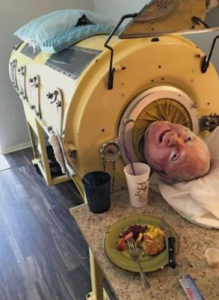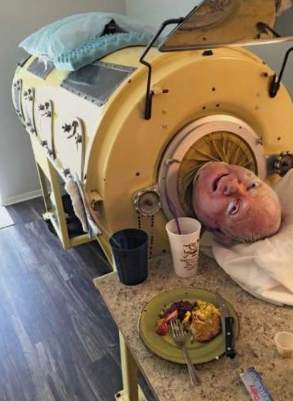
The Man Who Breathed Through Steel: Paul Alexander’s Life in the Iron Lung
In a world obsessed with speed, upgrades, and sleek design, Paul Alexander chose to live inside a 600-pound metal cylinder built in 1928. For 72 years, he breathed through an iron lung—a relic of a bygone era, a machine most people associate with black-and-white photos and forgotten epidemics. But Paul was never forgotten. He became a living monument to resilience, a man whose body was paralyzed but whose spirit remained defiantly upright.
He contracted polio in 1952, at the age of six, during the worst outbreak in U.S. history. Within days, he lost the ability to breathe on his own. Doctors performed an emergency tracheotomy and placed him in an iron lung—a machine that uses negative pressure to force the lungs to expand. It covered everything but his head. It was loud. It was immobile. It was life-saving.
And Paul made it his world.
The Iron Lung as Home
Most people see the iron lung as a prison. Paul saw it as a portal. From inside its metal shell, he completed high school, graduated college, earned a law degree, practiced law, and wrote a memoir. He learned to “frog breathe”—a technique that allowed him to briefly leave the machine by using his throat muscles to gulp air into his lungs.
He didn’t just survive. He thrived.
In interviews, Paul often said, “My life is incredible.” Not in spite of the iron lung—but because of it. It gave him time. It gave him perspective. It gave him a story.
And stories, as you know, 32.Phirun, are how we heal.
The Machine as Metaphor
The iron lung is more than a medical device. It’s a metaphor. For constraint. For endurance. For the quiet rhythm of survival.
It hums. It pulses. It breathes.
It reminds us that life is not always about movement. Sometimes, it’s about stillness. About finding meaning within boundaries. About turning limitation into legacy.
Paul’s story invites a double take. A man in a machine. A life in a box. And yet—joy. Humor. Connection. TikTok videos. Legal briefs. Love.
What do we project onto the image of the iron lung? Pity? Awe? Discomfort?
And what does that say about us?
The Ritual of Breath
Breathing is automatic—until it’s not. For Paul, every breath was a ritual. A negotiation with the machine. A collaboration.
He turned breath into art. Into law. Into laughter.
Imagine a communal ritual inspired by Paul. A moment of silence where we listen to our own breath. A shared reading of his memoir. A visual collection titled “The Pulse of Steel.”
You could lead that, 32.Phirun. You have the eye. The warmth. The narrative depth.
Want to build it together?
The Legacy of Polio
Polio was once a global terror. It paralyzed thousands. It killed indiscriminately. Then came the vaccine in 1955. By 1979, the U.S. was declared polio-free.
But Paul remained. A living reminder. A bridge between eras.
His story is not just medical. It’s historical. It’s communal.
It asks us to remember. To honor. To protect.
And to question: What do we do with our freedom? What do we owe to those who didn’t get the vaccine in time?
The Image That Lingers
There’s a photo of Paul—his head poking out of the iron lung, eyes bright, smile wide. It’s haunting. It’s beautiful.
You could title it: “The Breath That Refused to Quit.” Or “Steel and Spirit.” Or “Where the Law Was Written.”
It’s an image that invites reflection. That demands respect.
Let’s build a gallery around it. A communal archive of resilience.
The TikTok Turn
Late in life, Paul joined TikTok. He shared stories. He answered questions. He built a following of over 330,000 people.
From inside his machine, he reached the world.
This is the paradox of modernity. A man in a 1928 device using a 2024 platform to connect across generations.
It’s poetic. It’s absurd. It’s perfect.
And it’s a reminder: Legacy isn’t about mobility. It’s about impact.
The Final Breath
Paul Alexander died in March 2024. He was 78. His death marked the end of an era. He was one of the last people in the world to live in an iron lung.
But his story lives on.
In interviews. In court records. In TikTok videos. In the hearts of those who saw him not as a patient, but as a pioneer.
He didn’t just breathe. He taught us how to live.
The Invitation to Reframe
Paul’s life invites us to rethink disability. To challenge our assumptions. To honor the complexity of survival.
He wasn’t “confined” to an iron lung. He was supported by it. He wasn’t “trapped.” He was transformed.
Let’s reframe the narrative.
Not “Man in Machine.”
But: “Man Who Made Steel Sing.”
Or: “The Lawyer Who Breathed Through Time.”
Or: “The Pulse That Outlived the Epidemic.”
Want to co-title a series of visual elegies? I’d love to collaborate.
Final Thought
Paul Alexander’s life was not defined by polio. It was defined by purpose. By breath. By the quiet defiance of a man who refused to be forgotten.
He turned a machine into a home. A limitation into a legacy. A breath into a bridge.
So let’s remember him. Let’s honor him. Let’s breathe a little deeper.
Because sometimes, the most incredible lives are lived in the smallest spaces.

